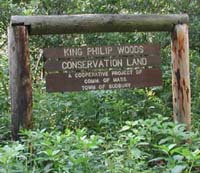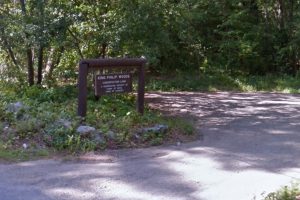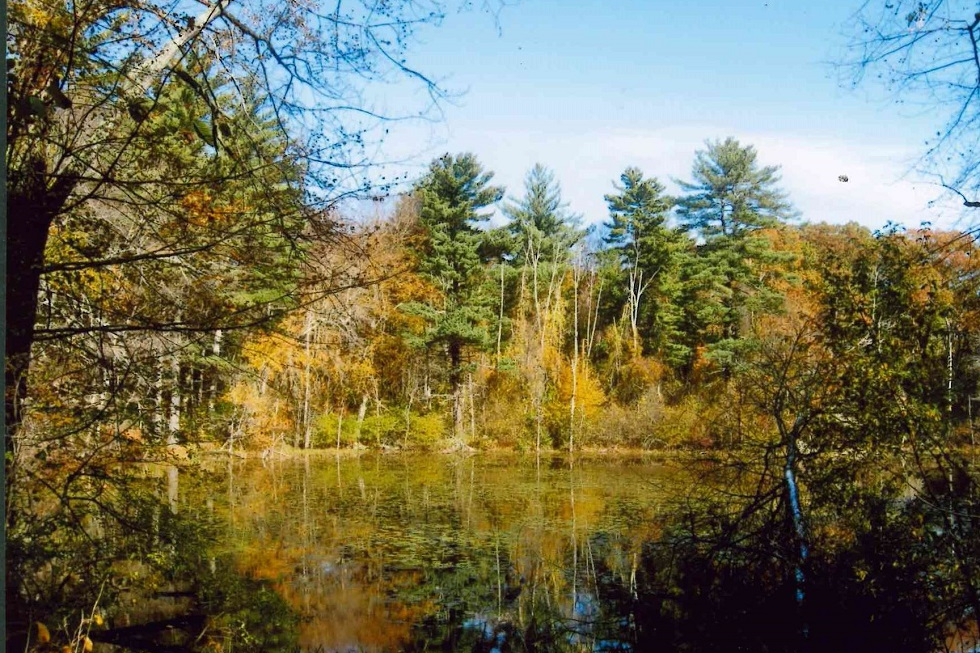King Philip Woods Conservation Land

The King Philip Woods Conservation Land was purchased jointly by the State Department of Environmental Management and the Town of Sudbury in 1987. The 81-acre conservation land consists of two parcels. On the easterly side of Water Row is 57 acres of Sudbury River floodplain with over 1,300 feet of frontage on the Sudbury River. With the exception of a scenic viewing area, this portion of the parcel is not open to the public to ensure preservation of the wildlife habitat value of the floodplain. The westerly side of Water Row is mostly a forested upland with diverse topography, trails, a small pond and bog, and several interesting historic foundations.
Trails from the King Philip property lead to the Haynes Garrison House. Hikers can also cross Water Row to view The Great Meadows National Wildlife Refuge at designated viewing areas. Haynes Garrison and The Great Meadows National Wildlife Refuge are not part of the King Philip property.
Parking
A small gravel parking area is available off of Old Sudbury Rd. near Wolbach Rd.

Historical Information
The abandoned Old Berlin Road, historically an important stagecoach road from Boston to Lancaster, is now a dirt road running through the upland side of the parcel from Water Row to Old Sudbury Road. A short distance in from Water Row, on the right of Old Berlin Road, the foundation of an old tavern exists. This was a 2 1/2 story structure about the size of the Wayside Inn. Historically, the structure was a stagecoach stop. It became a popular spot in the middle of the 18th century for certain unsavory “Gentlemen of the Road” namely highwaymen and horse thieves who were led by the notorious Captain Lightfoot. The Captain and his friends had plied their trade on the highways of England too successfully and, for reasons of personal health, were forced to leave their native land. Subsequently, it was noticed that several travelers who left by stage for Lancaster failed to arrive at their destination, and warnings were posted advising travelers of the hazards of stage travel. With suspicion leveled at it, the tavern became unpopular as a stopping place and gradually fell into disrepair. A later owner investigating a stone in the basement unearthed 13 skeletons – apparently the unfortunate travelers who never made it to Lancaster.
King Philip, also known as Metacom, Metacomet, or Pometacom, became Great Sachem of the Wampanoag Federation in 1662 after he inherited the power and influence of his father and brother. Philip succeeded in organizing the Native Americans of New England to fight against the English. He knew that, if the Native Americans did not go to war, they would have to submit to English authority. On April 21, 1676, Sudbury, Lancaster, and Marlborough were burned to the ground by marauding Native Americans under the command of King Philip. A feeling of impending crisis sent the Sudbury settlers to their six garrison houses. On that fateful day, a force of 1,000 to 1,500 Native Americans under King Philip infiltrated the woods, burned the isolated farmhouses, and attacked the garrisons. None of the garrison houses remain today, but the foundation of the Haynes Garrison House can be seen on the adjacent town-owned parcel. It was to the Haynes Garrison House that the two Concord survivors of the Native American massacre at the Four-Arch Bridge (at the Sudbury River in Wayland) fled for refuge. Here, the defenders showed such courage and fierce determination to defend their homes that the Native Americans gave up and faded into the woods. Perhaps the increasing frequency of musket fire from the direction of Green Hill drew the discouraged Native Americans over Goodman Hill to the main engagement. There, King Philip and his warriors finally overwhelmed the colonials that afternoon, but failed to consolidate their victory. By the end of the day, Philip had abandoned his plan to wipe out settlers all the way to Boston and turned back. In August of that year, Philip was killed in Rhode Island by one of his own men – the brother of a man Philip had killed for desertion. King Philip did not succeed in taking back any of the former Native American lands in New England. After Philip’s death, the war ended. Native American power in New England had been considerably weakened, and the future of Native Americans in New England was set. This began the slow descent into final defeat of the Native American peoples in southern New England.
Today, legends exist about Native Americans hurling a flaming hay cart down the hill toward the Haynes Garrison House while soldiers and families remained inside. Had the Haynes Garrison House been unable to protect the town’s earliest settlers against Native American attack, King Philip’s plan to wipe out every settlement eastward until he reached Boston might have succeeded. Philip suffered a significant setback in Sudbury, and it was here that he was made to turn back.
Excerpted in part from the book, Wayland A-Z: A Dictionary of Then and Now, by Evelyn Wolfson and Dick Hoyt, published in 2004 by the Wayland Historical Society.
Trail Challenges
The forested area contains hills and slopes, with multiple tree roots and rocks along the trails. Some of the slopes along the trails can be steep. However, the main trail is generally wide with average difficulty other than some slopes. Some of these wooded area trails also contain brush and are moderately challenging to hike.
Trail Comments
- “King Philip has a really nice pond area with lots of wildlife to see.”
- “The woods around King Philip are really interesting, with lots of stone walls and tall trees.”
- “Hikers can get a new perspective on the land on the big rock observation area.”
- “Haynes Garrison contains the old foundation and a stone marking the site. It is full of history. It is interesting to imagine the battle that occurred here.” NOTE: Haynes Garrison is not part of the King Philip property.
- “Across the street, there is a wonderful view of the Great Meadows. You can see the land for miles.” NOTE: Great Meadows is not part of the King Philip property.
Trail Videos
King Philip Woods – Highlights
King Philip Woods – Trail Hike
Trail Photographs


